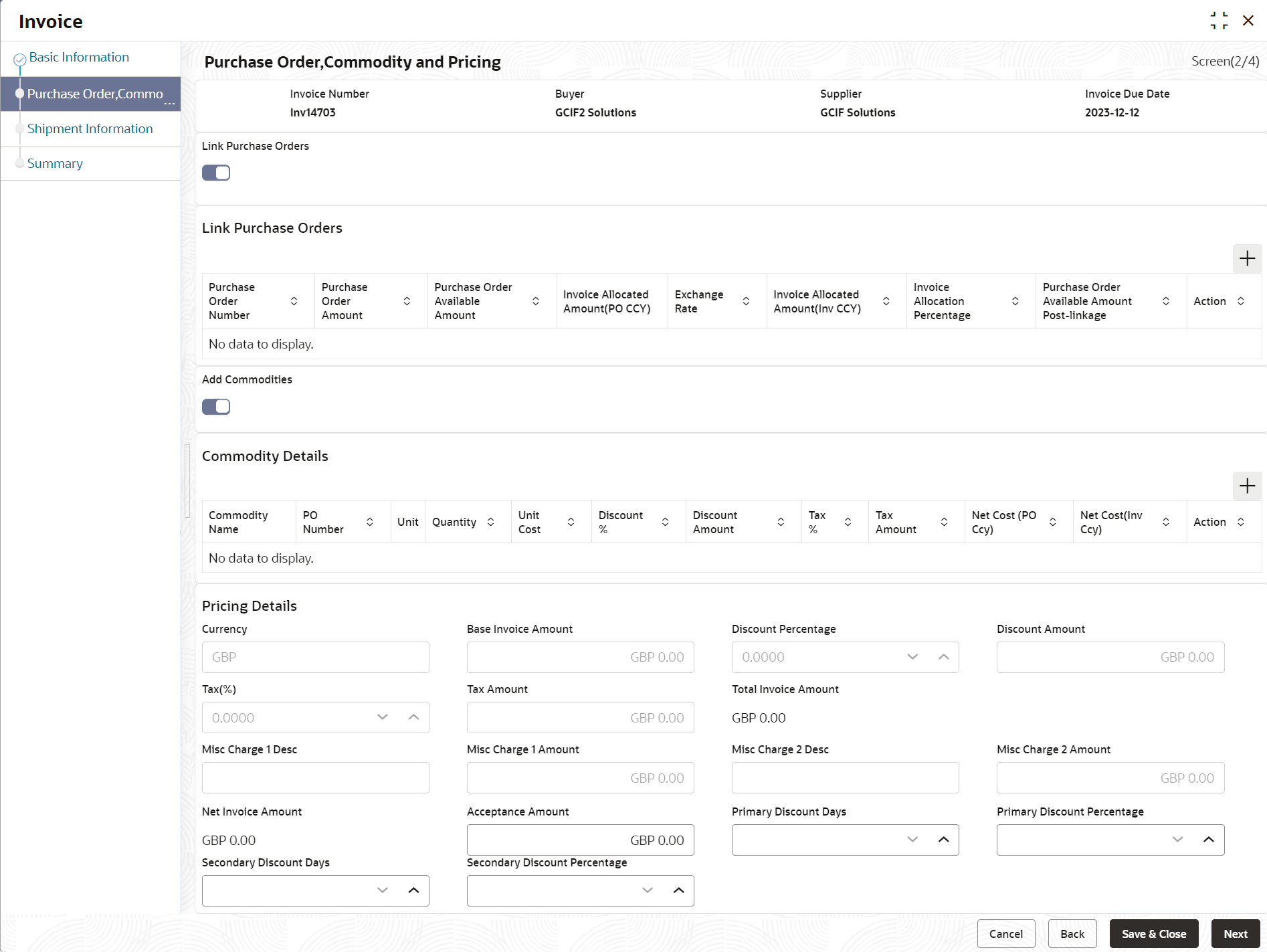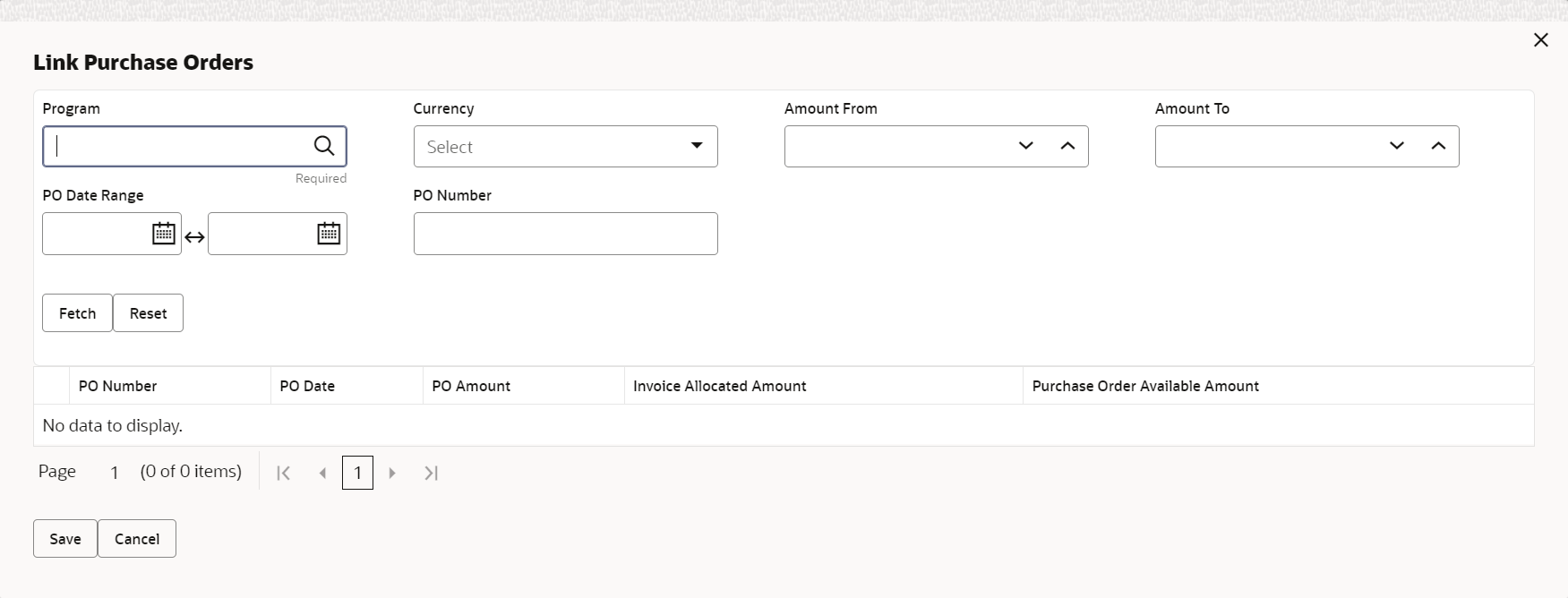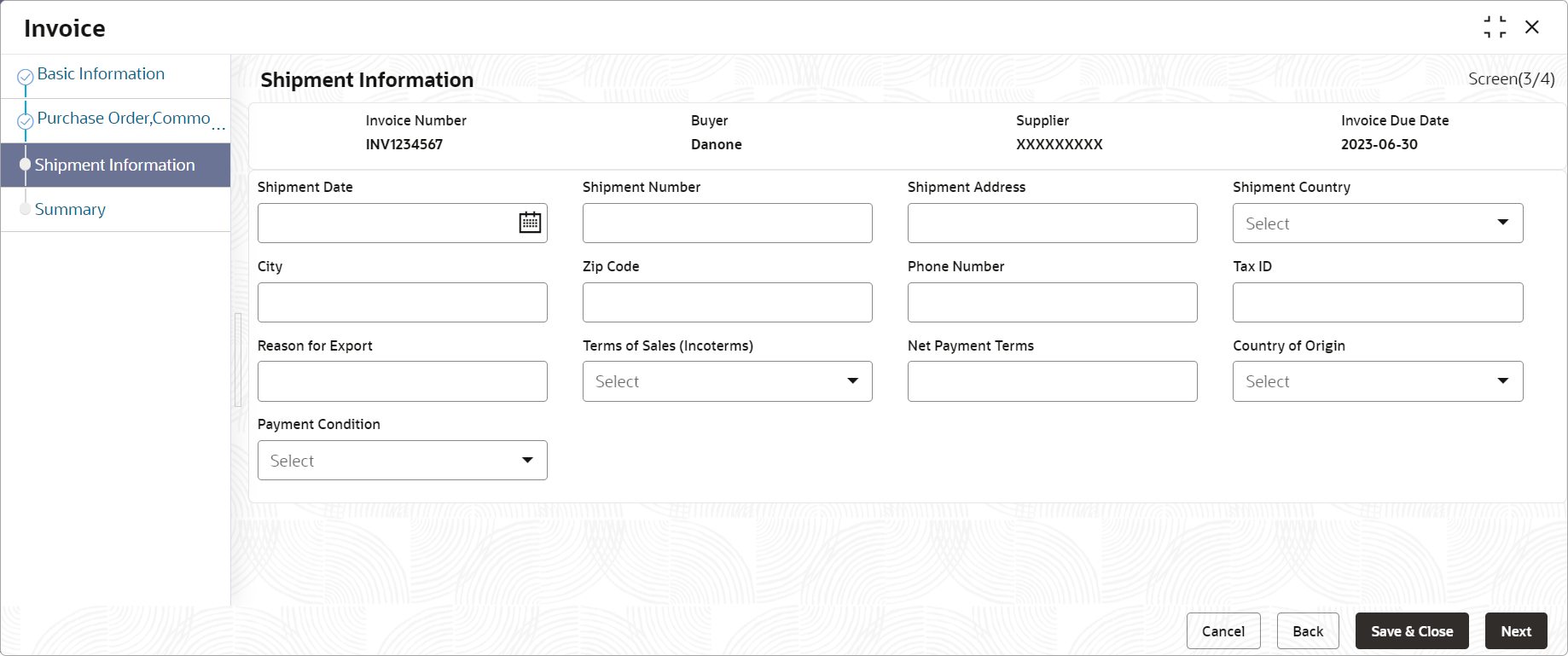4.1 Create Invoice
This topic describes the systematic instruction to create an invoice using Create Receivables and Payables screen.
- On Create Receivables and Payables screen, select Invoice from the Instrument Type list.
Basic Information
- Click Proceed to view the screen for populating the invoice details.The Invoice - Basic Information screen displays.
- Specify the fields on Basic Information screen.For more information on fields, refer to the field description table.
Note:
The fields marked as Required are mandatory.Table 4-2 Basic Information - Field Description
Field Description Invoice Number Specify the unique reference number for invoice to be created. OR
Click the Search icon to select the existing invoice number.
This field cannot be modified once authorized.
Invoice Date Click the Calendar icon and select the date of invoice creation. By default, the system’s current date is set. Invoice Value Date Click the Calendar icon and select the invoice value date. This date may be different from the invoice date. Invoice Due Date Click the Calendar icon and select the date by when the invoice is due. Supplier Click the Search icon and select the supplier of the goods/commodity. This field cannot be modified once authorized.
Relationship Click the Search icon and select the relationship of the selected supplier under which this invoice should be created. This field cannot be modified once authorized.
Program Click the Search icon and select the required program under which the invoice should be created. This field is applicable to only OBSCF system.
Buyer Click the Search icon and select the buyer to create the invoice for. This field cannot be modified once authorized.
Supplier Division Code Click the Search icon and select the division code of the supplier. Buyer Division Code Click the Search icon and select the division code of the buyer. Currency Select the currency of the invoice. Pre-Accepted Switch the toggle ON if the invoice is pre-accepted by the buyer. BIC Routing Code Specify the BIC or SWIFT code of the financial institution, to send the payment amount to. Funding Request Date Click the Calendar icon and select the date on which funding for the invoice was requested. Remarks Specify the comments regarding the invoice, if any. Virtual Account Switch the toggle ON, if the repayment account is a virtual one. Bank Specify the bank name of the repayment account. Branch Specify the branch name of the repayment account. Repayment Account Number Specify the account number to send the repayment amount to. Filler Fields/Miscellaneous Fields Specify the desired values in the filler fields. The bank can configure these fields on Day Zero based on their requirement. - Perform any of the below action from the Basic Information screen.
- Click Next to go to the Purchase Order, Commodity and Pricing screen.
- Click Save & Close to save the invoice details and submit it for authorization.
- Click Cancel to cancel the creation of the invoice.
Purchase Order, Commodity and Pricing
- Click Next on Basic Information tab.The Invoice - Commodity and Pricing screen displays.For more information on fields, refer to the field description table.
Figure 4-3 Invoice - Purchase Order, Commodity and Pricing
Table 4-3 Purchase Order, Commodity and Pricing - Field Description
Field Description Invoice Number Displays the reference number of the invoice. Buyer Displays the name of the buyer. Supplier Displays the name of the supplier. Invoice Due Date Displays the date when the invoice is due. - Switch the Link Purchase Orders toggle ON to link one or more purchase orders to the invoice.
- In the Link Purchase Orders section, click Add icon to link one or more purchase orders to the invoice.The Link Purchase Orders screen displays.
- On the Link Purchase Orders screen, specify the required search criteria and click Fetch.The relevant purchase order records are displayed.
- Select the records and click Save to link the purchase orders to the invoice.The Link Purchase Orders section displays with the linked purchase orders.For more information on fields, refer to the field description table.
Table 4-4 Link Purchase Orders - Field Description
Field Description Purchase Order Number Displays the purchase order numbers of the same buyer-seller combination as the invoice. Purchase Order Amount Displays the purchase order amount. Purchase Order Available Amount Displays the purchase order amount as purchase order available amount. Once a purchase order is linked to an invoice, Purchase Order Available Amount = Purchase Order Amount - Invoice Allocated Amount.
Invoice Allocated Amount (PO CCY) Displays the invoice amount allocated to a purchase order in PO currency. This field is editable and allows you to add the amount manually as well. On entering this value, the invoice allocation percentage is automatically updated. If Purchase Order Available Amount is greater than or equal to Invoice Amount, the entire invoice amount is allocated to the PO by default. If not, the invoice Amount to the extent of PO Available Amount is allocated to the purchase order.
Exchange Rate Displays the exchange rate between invoice currency and PO currency. Invoice Allocated Amount (Inv CCY) Displays the invoice amount allocated to a purchase order in invoice currency. Invoice Allocation Percentage Displays the percentage of invoice amount allocated to a purchase order. This field is editable and allows you to add the percentage manually as well. On entering this value, the invoice allocated amount is automatically updated. Purchase Order Available Amount Post-Linkage Displays the available purchase order amount post the linkage with invoice. Action Displays the following options to edit or delete the purchase order record. - Click Edit icon to edit the record.
- Click Delete icon to delete the record.
- In the Link Purchase Orders section, click Add icon to link one or more purchase orders to the invoice.
- Switch the Add Commodities toggle ON to add the Commodity details.
- In the Add Commodities section, click Add icon to add the commodity details.For more information on fields, refer to the field description table.
Table 4-5 Commodity Details - Field Description
Field Description Commodity Details Displays the fields related to the Commodity details. This section appears if the Add Commodities toggle is switched ON.
PO Number Displays the reference number of the linked purchase orders. Commodity Name Displays the commodity name based on the selected commodity code. Unit Select the measuring unit for the goods. Quantity Specify the quantity of the goods as per selected measuring unit. Unit Cost Specify a single unit’s cost of the goods. Discount (%) Specify the percentage of discount to be applied on the total cost. Discount Amount Displays the discount amount based on the discount percentage. Tax (%) Specify the percentage of tax to be applied on total amount post discounting. Tax Amount Displays the tax amount based on tax percentage. Net Cost (PO Ccy) Displays the total amount of the commodity after discount, and inclusion of tax. Total Net Cost should be equal to Total Invoice Allocated Amount. The value is displayed in the PO Currency.
Net Cost (Inv Ccy) Displays the total amount of the commodity after discount, and inclusion of tax. Total Net Cost should be equal to Total Invoice Allocated Amount. The value is displayed in the Invoice Currency.
Action Displays the following options to edit or delete the commodity details. - Click Edit icon to edit the record.
- Click Delete icon to delete the record.
- In the Pricing Details section, specify the following pricing details.For more information on fields, refer to the field description table.
Note:
The fields marked as Required are mandatory.Table 4-6 Pricing Details - Field Description
Field Description Currency Displays the selected currency. Base Invoice Amount Displays the base amount of the invoice. This field is editable and allows you to add the base amount manually, if the Base Invoice Amount is greater than or equal to the Total Net Cost. Discount Percentage Specify the percentage of discount to be applied on the base invoice amount. Discount percentage is auto-calculated based on entered discount amount. Discount Amount Specify the amount to be discounted from the base invoice amount. Discount amount is auto-calculated based on entered discount percentage. Tax (%) Specify the percentage of tax to be levied on the total invoice amount. Tax percentage is auto-calculated based on entered tax amount. Tax Amount Specify the amount of tax to be levied on the total invoice amount. Tax amount is auto-calculated based on entered tax percentage. Total Invoice Amount Displays the total invoice amount post calculating base invoice amount, discount, and tax. Misc Charge 1 Desc Specify the description of the miscellaneous charges to be added in total invoice amount. Misc Charge 1 Amount Specify the miscellaneous charge amount to be added in total invoice amount. Misc Charge 2 Desc Specify the description of another miscellaneous charges to be added in total invoice amount. Misc Charge 2 Amount Specify the miscellaneous charge amount to be added in total invoice amount. Net Invoice Amount Displays the net invoice amount post adding miscellaneous charges in the total invoice amount. Acceptance Amount Specify the invoice amount that has been accepted by the Buyer. Primary Discount Days Specify the primary discount days. Primary Discount Percentage Specify the primary discount percentage. Secondary Discount Days Specify the secondary discount days. Secondary Discount Percentage Specify the secondary discount percentage. - Perform any of the following action from the Commodity and Pricing screen:
- Click Next to go to the Shipment Information screen.
- Click Save & Close to save the invoice details and submit it for authorization.
- Click Back to go to the Basic Information screen.
- Click Cancel to cancel the creation of the invoice.
Shipment Information
- Click Next on Commodity and Pricing tab.The Invoice - Shipment Information screen displays.
- Specify the fields on Shipment Information screen.For more information on fields, refer to the field description table.
Note:
The fields marked as Required are mandatory.Table 4-7 Shipment Information - Field Description
Field Description Invoice Number Displays the reference number of the invoice. Buyer Displays the name of the buyer. Supplier Displays the name of the supplier. Invoice Due Date Displays the date when the invoice is due. Shipment Date Click the Calendar icon and select the date on which the buyer expects commodity to get dispatched. Shipment Number Specify the unique shipment number to track the shipment. Shipment Address Specify the complete address where shipment should be sent. Shipment Country Select the country to send the shipment to. City Select the city to send the shipment to. Zip Code Specify the postal code to send the shipment to. Phone Number Specify the contact number of the shipment company. Tax Id Specify the unique tax id if shipment charge includes tax amount. Reason for Export Specify the reason for exporting the shipment. Terms of Sale(Incoterms) Select any of the following terms of sales: - DAF – Delivered At Frontier
- DES - Delivered Ex Ship
- DEQ - Delivered Ex Quay
- DDU - Delivered Duty Unpaid
- CIP - Carriage and Insurance Paid To
- CPT - Carriage Paid To
- CIF - Cost, Insurance and Freight
- CFR - Cost and Freight
- FOB - Free On Board
- DDP - Delivered Duty Paid
- FCA - Free Carrier
- EXW - Ex Works
- FAS - Free Alongside Ship
Net Payment Terms Specify the terms of payments, if any. Country of Origin Select the country from where the shipment is being sent. Payment Condition Select the payment condition. The options are: - Open Account
- Bill of exchange against acceptance
- Bill of exchange against payment
- Documents through banks
- Instalment payment without draft
- Instalment payment with draft
- Other
- Perform any of the below action from the Shipment Information screen:
- Click Next to go to the Summary screen.
- Click Save & Close to save the invoice details and submit it for authorization.
- Click Back to go to the Commodity and Pricing screen.
- Click Cancel to cancel the creation of the invoice.
Summary
- Click Next on Shipment Information tab.The Invoice - Summary screen displays.
- Review the detail of the invoice being created and perform any of the following action from the Summary screen.
- Click Save & Close to save the invoice details and submit it for authorization.
- Click Back to go to the Shipment Information screen.
- Click Cancel to cancel the creation of the invoice.
Note:
A cashflow record is automatically created for every new invoice record, if the ‘Create Cashflow from Invoice’ system-level configuration parameter is set to ‘Yes’.
Parent topic: Create Receivables and Payables




